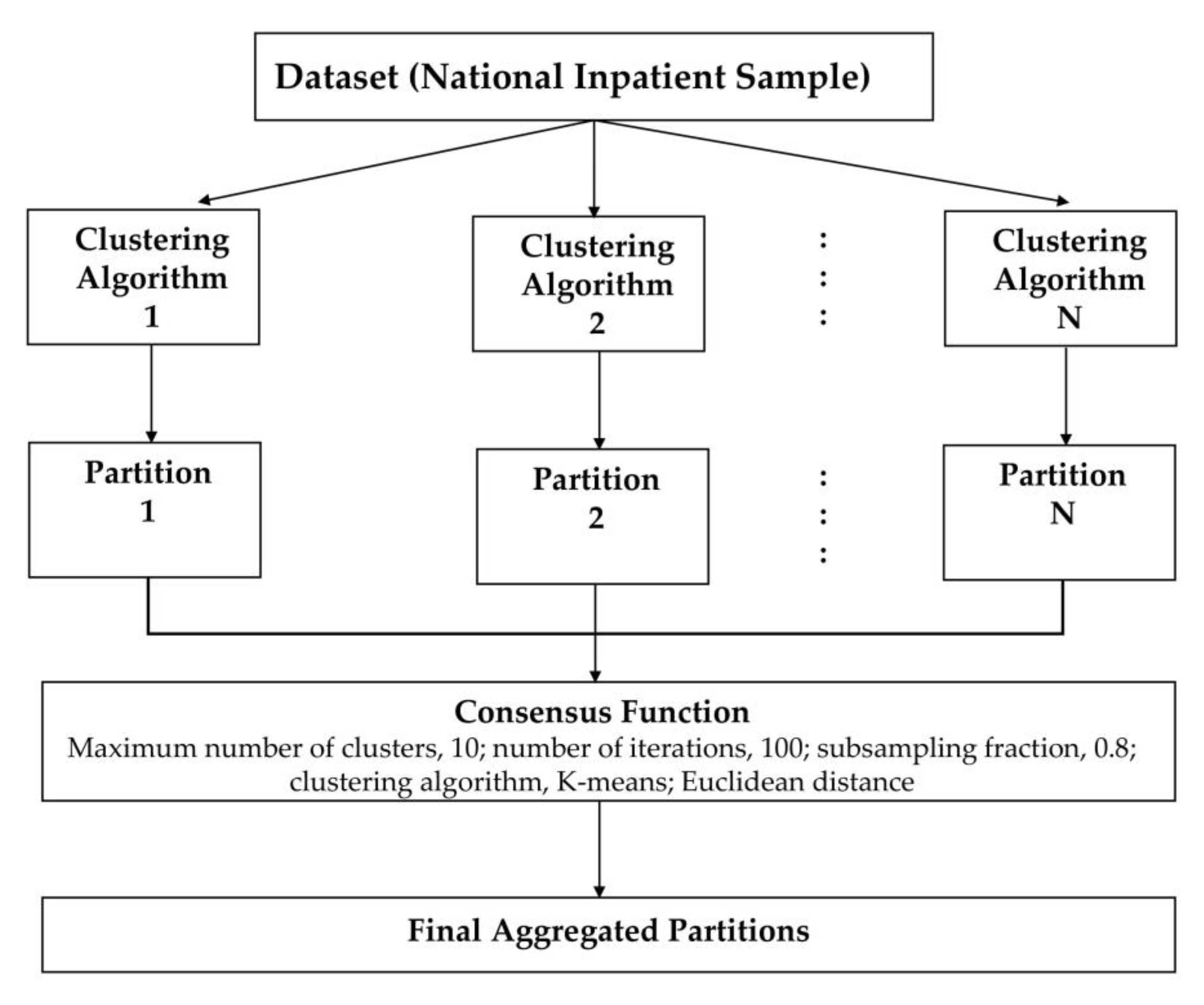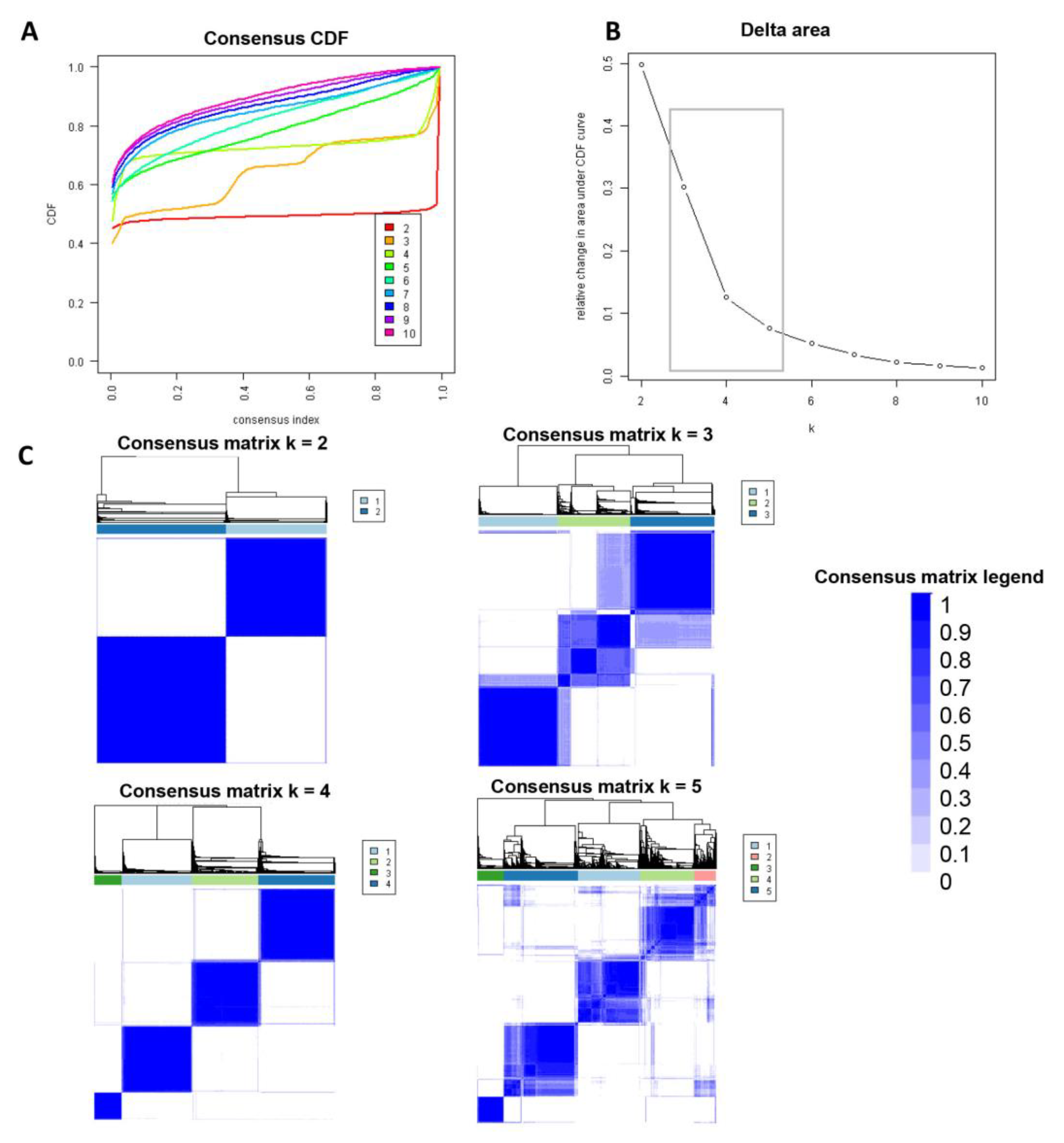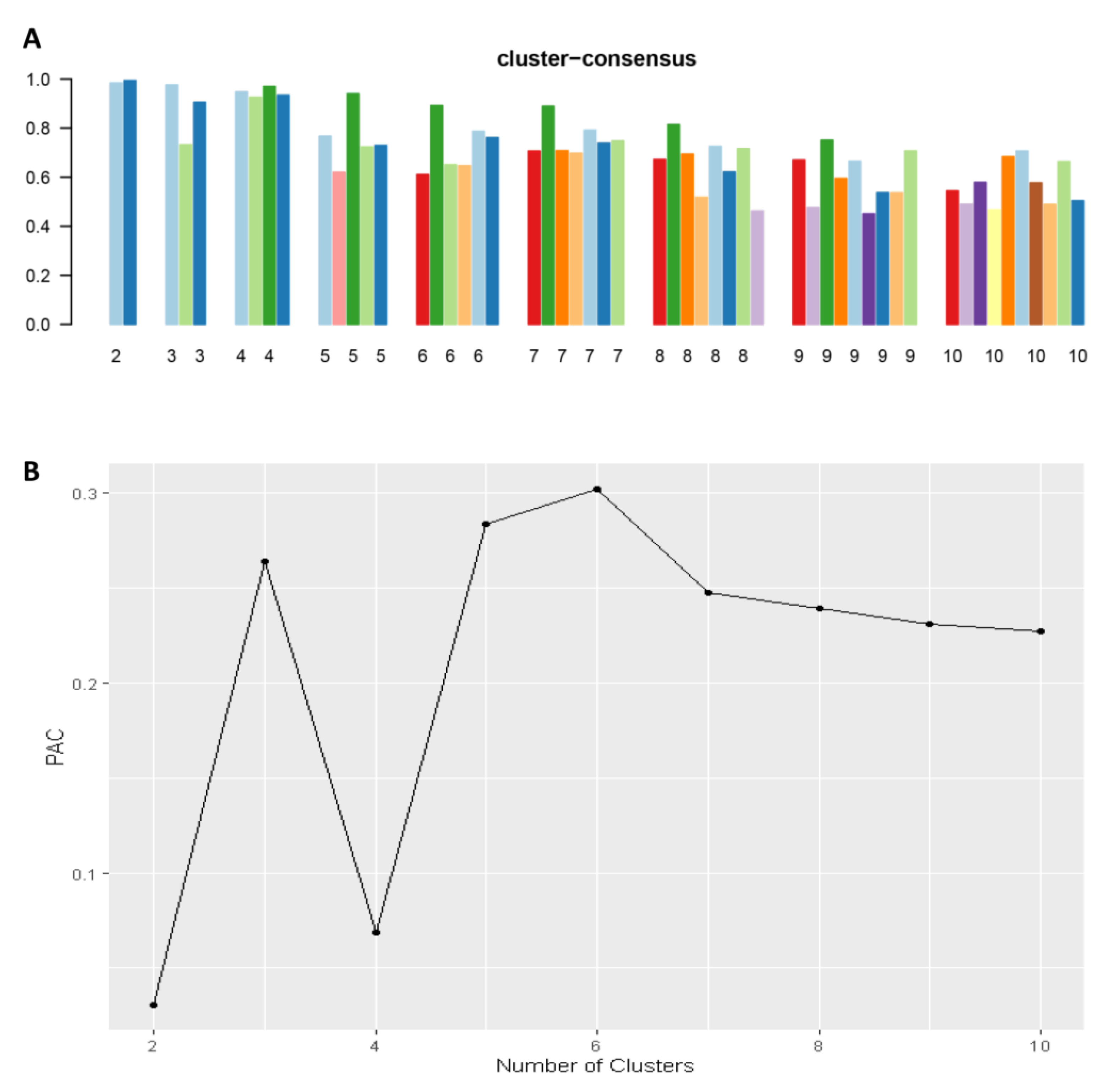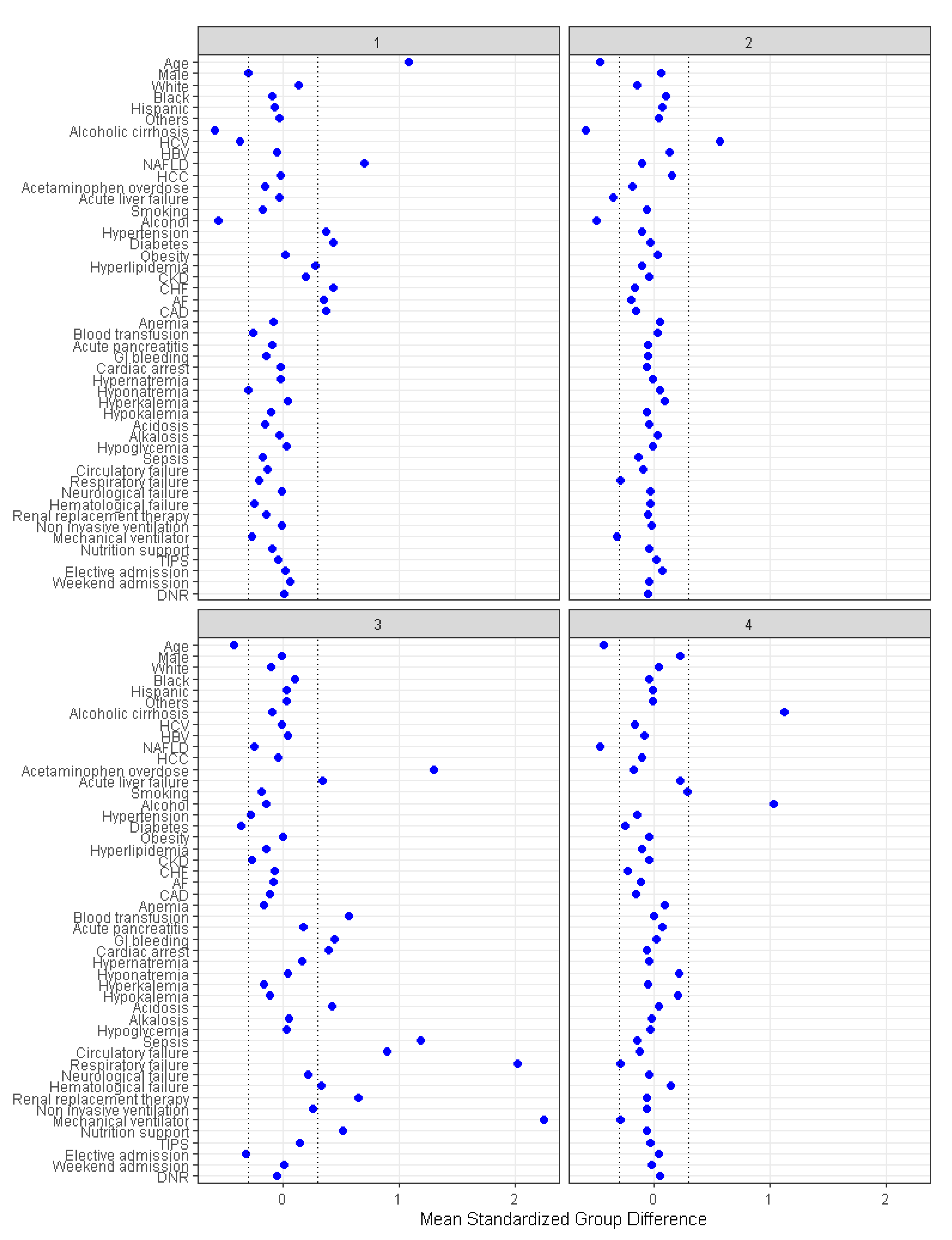Distinct Subtypes of Hepatorenal Syndrome and Associated Outcomes as Identified by Machine Learning Consensus Clustering
Abstract
:1. Introduction
2. Materials and Methods
2.1. Study Population
2.2. Data Collection
2.3. Clustering Analysis
2.4. Statistical Analysis
3. Results
4. Discussion
5. Conclusions
Supplementary Materials
Author Contributions
Funding
Institutional Review Board Statement
Informed Consent Statement
Data Availability Statement
Conflicts of Interest
References
- Wadei, H.M.; Mai, M.L.; Ahsan, N.; Gonwa, T.A. Hepatorenal syndrome: Pathophysiology and management. Clin. J. Am. Soc. Nephrol 2006, 1, 1066–1079. [Google Scholar] [CrossRef] [PubMed]
- Francoz, C.; Durand, F.; Kahn, J.A.; Genyk, Y.S.; Nadim, M.K. Hepatorenal Syndrome. Clin. J. Am. Soc. Nephrol. 2019, 14, 774–781. [Google Scholar] [CrossRef] [PubMed]
- Simonetto, D.A.; Gines, P.; Kamath, P.S. Hepatorenal syndrome: Pathophysiology, diagnosis, and management. BMJ 2020, 370, m2687. [Google Scholar] [CrossRef] [PubMed]
- Fagundes, C.; Barreto, R.; Guevara, M.; Garcia, E.; Solà, E.; Rodríguez, E.; Graupera, I.; Ariza, X.; Pereira, G.; Alfaro, I.; et al. A modified acute kidney injury classification for diagnosis and risk stratification of impairment of kidney function in cirrhosis. J. Hepatol. 2013, 59, 474–481. [Google Scholar] [CrossRef]
- Wu, C.C.; Yeung, L.K.; Tsai, W.S.; Tseng, C.F.; Chu, P.; Huang, T.Y.; Lin, Y.F.; Lu, K.C. Incidence and factors predictive of acute renal failure in patients with advanced liver cirrhosis. Clin. Nephrol. 2006, 65, 28–33. [Google Scholar] [CrossRef]
- Piano, S.; Rosi, S.; Maresio, G.; Fasolato, S.; Cavallin, M.; Romano, A.; Morando, F.; Gola, E.; Frigo, A.C.; Gatta, A.; et al. Evaluation of the Acute Kidney Injury Network criteria in hospitalized patients with cirrhosis and ascites. J. Hepatol. 2013, 59, 482–489. [Google Scholar] [CrossRef]
- Sujan, R.; Cruz-Lemini, M.; Altamirano, J.; Simonetto, D.A.; Maiwall, R.; Axley, P.; Richardson, T.; Desai, V.; Cabezas, J.; Vargas, V.; et al. A Validated Score Predicts Acute Kidney Injury and Survival in Patients With Alcoholic Hepatitis. Liver Transpl. 2018, 24, 1655–1664. [Google Scholar] [CrossRef]
- Makar, M.; Reja, D.; Chouthai, A.; Kabaria, S.; Patel, A.V. The impact of acute kidney injury on mortality and clinical outcomes in patients with alcoholic cirrhosis in the USA. Eur. J. Gastroenterol. Hepatol. 2021, 33, 905–910. [Google Scholar] [CrossRef]
- Pant, C.; Jani, B.S.; Desai, M.; Deshpande, A.; Pandya, P.; Taylor, R.; Gilroy, R.; Olyaee, M. Hepatorenal syndrome in hospitalized patients with chronic liver disease: Results from the Nationwide Inpatient Sample 2002–2012. J. Investig. Med. 2016, 64, 33–38. [Google Scholar] [CrossRef]
- Amin, A.A.; Alabsawy, E.I.; Jalan, R.; Davenport, A. Epidemiology, Pathophysiology, and Management of Hepatorenal Syndrome. Semin. Nephrol. 2019, 39, 17–30. [Google Scholar] [CrossRef]
- McCormick, P.A. Improving prognosis in hepatorenal syndrome. Gut 2000, 47, 166–167. [Google Scholar] [CrossRef]
- Mohan, S.; Huff, E.; Wish, J.; Lilly, M.; Chen, S.C.; McClellan, W.M.; Fistula First Breakthrough Initiative Data, C. Recovery of renal function among ESRD patients in the US medicare program. PLoS ONE 2013, 8, e83447. [Google Scholar] [CrossRef]
- Ginès, P. Diagnosis and treatment of hepatorenal syndrome. Best Pract. Res. Clin. Gastroenterol. 2000, 14, 945–957. [Google Scholar] [CrossRef]
- Gines, P.; Guevara, M.; Arroyo, V.; Rodes, J. Hepatorenal syndrome. Lancet 2003, 362, 1819–1827. [Google Scholar] [CrossRef]
- Alessandria, C.; Ozdogan, O.; Guevara, M.; Restuccia, T.; Jimenez, W.; Arroyo, V.; Rodes, J.; Gines, P. MELD score and clinical type predict prognosis in hepatorenal syndrome: Relevance to liver transplantation. Hepatology 2005, 41, 1282–1289. [Google Scholar] [CrossRef]
- Martin-Llahi, M.; Pepin, M.N.; Guevara, M.; Diaz, F.; Torre, A.; Monescillo, A.; Soriano, G.; Terra, C.; Fabrega, E.; Arroyo, V.; et al. Terlipressin and albumin vs albumin in patients with cirrhosis and hepatorenal syndrome: A randomized study. Gastroenterology 2008, 134, 1352–1359. [Google Scholar] [CrossRef]
- Piano, S.; Schmidt, H.H.; Ariza, X.; Amoros, A.; Romano, A.; Husing-Kabar, A.; Sola, E.; Gerbes, A.; Bernardi, M.; Alessandria, C.; et al. Association Between Grade of Acute on Chronic Liver Failure and Response to Terlipressin and Albumin in Patients With Hepatorenal Syndrome. Clin. Gastroenterol. Hepatol. 2018, 16, 1792–1800. [Google Scholar] [CrossRef]
- Solé, C.; Solà, E.; Huelin, P.; Carol, M.; Moreira, R.; Cereijo, U.; Mas, J.M.; Graupera, I.; Pose, E.; Napoleone, L.; et al. Characterization of inflammatory response in hepatorenal syndrome: Relationship with kidney outcome and survival. Liver Int 2019, 39, 1246–1255. [Google Scholar] [CrossRef]
- Wong, F.; Boyer, T.D.; Sanyal, A.J.; Pappas, S.C.; Escalante, S.; Jamil, K. Reduction in acute kidney injury stage predicts survival in patients with type-1 hepatorenal syndrome. Nephrol. Dial. Transplant. 2020, 35, 1554–1561. [Google Scholar] [CrossRef]
- Wong, F.; Pappas, S.C.; Boyer, T.D.; Sanyal, A.J.; Bajaj, J.S.; Escalante, S.; Jamil, K.; Investigators, R. Terlipressin Improves Renal Function and Reverses Hepatorenal Syndrome in Patients With Systemic Inflammatory Response Syndrome. Clin. Gastroenterol. Hepatol. 2017, 15, 266–272. [Google Scholar] [CrossRef]
- Kaewput, W.; Thongprayoon, C.; Dumancas, C.Y.; Kanduri, S.R.; Kovvuru, K.; Kaewput, C.; Pattharanitima, P.; Petnak, T.; Lertjitbanjong, P.; Boonpheng, B.; et al. In-hospital mortality of hepatorenal syndrome in the United States: Nationwide inpatient sample. World J. Gastroenterol. 2021, 27, 7831–7843. [Google Scholar] [CrossRef] [PubMed]
- Li, Q.; Fan, Q.L.; Han, Q.X.; Geng, W.J.; Zhao, H.H.; Ding, X.N.; Yan, J.Y.; Zhu, H.Y. Machine learning in nephrology: Scratching the surface. Chin. Med. J. 2020, 133, 687–698. [Google Scholar] [CrossRef] [PubMed]
- Rajkomar, A.; Dean, J.; Kohane, I. Machine Learning in Medicine. N. Engl. J. Med. 2019, 380, 1347–1358. [Google Scholar] [CrossRef] [PubMed]
- Baxter, R.D.; Fann, J.I.; DiMaio, J.M.; Lobdell, K. Digital Health Primer for Cardiothoracic Surgeons. Ann. Thorac. Surg. 2020, 110, 364–372. [Google Scholar] [CrossRef]
- Chae, D. Data science and machine learning in anesthesiology. Korean J. Anesth. 2020, 73, 285–295. [Google Scholar] [CrossRef]
- Yuan, Q.; Zhang, H.; Deng, T.; Tang, S.; Yuan, X.; Tang, W.; Xie, Y.; Ge, H.; Wang, X.; Zhou, Q.; et al. Role of Artificial Intelligence in Kidney Disease. Int. J. Med. Sci. 2020, 17, 970–984. [Google Scholar] [CrossRef]
- Sanchez-Pinto, L.N.; Venable, L.R.; Fahrenbach, J.; Churpek, M.M. Comparison of variable selection methods for clinical predictive modeling. Int. J. Med. Inform. 2018, 116, 10–17. [Google Scholar] [CrossRef]
- Yin, W.j.; Yi, Y.h.; Guan, X.f.; Zhou, L.y.; Wang, J.l.; Li, D.y.; Zuo, X.c. Preprocedural Prediction Model for Contrast-Induced Nephropathy Patients. J. Am. Heart Assoc. 2017, 6, e004498. [Google Scholar] [CrossRef]
- Tang, C.Q.; Li, J.Q.; Xu, D.Y.; Liu, X.B.; Hou, W.J.; Lyu, K.Y.; Xiao, S.C.; Xia, Z.F. Comparison of machine learning method and logistic regression model in prediction of acute kidney injury in severely burned patients. Zhonghua Shao Shang Za Zhi 2018, 34, 343–348. [Google Scholar] [CrossRef]
- Zimmerman, L.P.; Reyfman, P.A.; Smith, A.D.R.; Zeng, Z.; Kho, A.; Sanchez-Pinto, L.N.; Luo, Y. Early prediction of acute kidney injury following ICU admission using a multivariate panel of physiological measurements. BMC Med. Inform. Decis. Mak. 2019, 19, 16. [Google Scholar] [CrossRef]
- Goldstein, B.A.; Navar, A.M.; Carter, R.E. Moving beyond regression techniques in cardiovascular risk prediction: Applying machine learning to address analytic challenges. Eur. Heart J. 2017, 38, 1805–1814. [Google Scholar] [CrossRef] [PubMed]
- Szlosek, D.A.; Ferrett, J. Using Machine Learning and Natural Language Processing Algorithms to Automate the Evaluation of Clinical Decision Support in Electronic Medical Record Systems. eGEMs 2016, 4, 1222. [Google Scholar] [CrossRef] [PubMed]
- Lee, H.-C.; Yoon, H.-K.; Nam, K.; Cho, Y.J.; Kim, T.K.; Kim, W.H.; Bahk, J.-H. Derivation and Validation of Machine Learning Approaches to Predict Acute Kidney Injury after Cardiac Surgery. J. Clin. Med. 2018, 7, 322. [Google Scholar] [CrossRef] [PubMed]
- Rau, C.-S.; Wu, S.-C.; Chuang, J.-F.; Huang, C.-Y.; Liu, H.-T.; Chien, P.-C.; Hsieh, C.-H. Machine Learning Models of Survival Prediction in Trauma Patients. J. Clin. Med. 2019, 8, 799. [Google Scholar] [CrossRef] [PubMed]
- Chicco, D.; Jurman, G. Machine learning can predict survival of patients with heart failure from serum creatinine and ejection fraction alone. BMC Med. Inform. Decis. Mak. 2020, 20, 16. [Google Scholar] [CrossRef]
- Cao, Y.; Fang, X.; Ottosson, J.; Näslund, E.; Stenberg, E. A Comparative Study of Machine Learning Algorithms in Predicting Severe Complications after Bariatric Surgery. J. Clin. Med. 2019, 8, 668. [Google Scholar] [CrossRef]
- Lin, K.; Hu, Y.; Kong, G. Predicting in-hospital mortality of patients with acute kidney injury in the ICU using random forest model. Int. J. Med. Inform. 2019, 125, 55–61. [Google Scholar] [CrossRef]
- MacEachern, S.J.; Forkert, N.D. Machine learning for precision medicine. Genome 2021, 64, 416–425. [Google Scholar] [CrossRef]
- Thongprayoon, C.; Nissaisorakarn, V.; Pattharanitima, P.; Mao, M.A.; Kattah, A.G.; Keddis, M.T.; Dumancas, C.Y.; Vallabhajosyula, S.; Petnak, T.; Erickson, S.B.; et al. Subtyping Hyperchloremia among Hospitalized Patients by Machine Learning Consensus Clustering. Medicina 2021, 57, 903. [Google Scholar] [CrossRef]
- Thongprayoon, C.; Mao, M.A.; Keddis, M.T.; Kattah, A.G.; Chong, G.Y.; Pattharanitima, P.; Nissaisorakarn, V.; Garg, A.K.; Erickson, S.B.; Dillon, J.J.; et al. Hypernatremia subgroups among hospitalized patients by machine learning consensus clustering with different patient survival. J. Nephrol. 2022, 35, 921–929. [Google Scholar] [CrossRef]
- Thongprayoon, C.; Hansrivijit, P.; Mao, M.A.; Vaitla, P.K.; Kattah, A.G.; Pattharanitima, P.; Vallabhajosyula, S.; Nissaisorakarn, V.; Petnak, T.; Keddis, M.T.; et al. Machine Learning Consensus Clustering of Hospitalized Patients with Admission Hyponatremia. Diseases 2021, 9, 54. [Google Scholar] [CrossRef]
- Thongprayoon, C.; Kattah, A.G.; Mao, M.A.; Keddis, M.T.; Pattharanitima, P.; Vallabhajosyula, S.; Nissaisorakarn, V.; Erickson, S.B.; Dillon, J.J.; Garovic, V.D.; et al. Distinct phenotypes of hospitalized patients with hyperkalemia by machine learning consensus clustering and associated mortality risks. QJM 2022, 115, 442–449. [Google Scholar] [CrossRef]
- Zheng, Z.; Waikar, S.S.; Schmidt, I.M.; Landis, J.R.; Hsu, C.Y.; Shafi, T.; Feldman, H.I.; Anderson, A.H.; Wilson, F.P.; Chen, J.; et al. Subtyping CKD Patients by Consensus Clustering: The Chronic Renal Insufficiency Cohort (CRIC) Study. J. Am. Soc. Nephrol. 2021, 32, 639–653. [Google Scholar] [CrossRef]
- Thongprayoon, C.; Vaitla, P.; Jadlowiec, C.C.; Leeaphorn, N.; Mao, S.A.; Mao, M.A.; Pattharanitima, P.; Bruminhent, J.; Khoury, N.J.; Garovic, V.D.; et al. Use of Machine Learning Consensus Clustering to Identify Distinct Subtypes of Black Kidney Transplant Recipients and Associated Outcomes. JAMA Surg. 2022, 157, e221286. [Google Scholar] [CrossRef]
- Monti, S.; Tamayo, P.; Mesirov, J.; Golub, T. Consensus clustering: A resampling-based method for class discovery and visualization of gene expression microarray data. Mach. Learn. 2003, 52, 91–118. [Google Scholar] [CrossRef]
- Șenbabaoğlu, Y.; Michailidis, G.; Li, J.Z. Critical limitations of consensus clustering in class discovery. Sci. Rep. 2014, 4, 6207. [Google Scholar] [CrossRef]
- Wilkerson, M.D.; Hayes, D.N. ConsensusClusterPlus: A class discovery tool with confidence assessments and item tracking. Bioinformatics 2010, 26, 1572–1573. [Google Scholar] [CrossRef]
- Bauer, M.; Gerlach, H.; Vogelmann, T.; Preissing, F.; Stiefel, J.; Adam, D. Mortality in sepsis and septic shock in Europe, North America and Australia between 2009 and 2019—Results from a systematic review and meta-analysis. Crit. Care 2020, 24, 239. [Google Scholar] [CrossRef]
- Batra, Y.; Acharya, S.K. Acute liver failure: Prognostic markers. Indian J. Gastroenterol. 2003, 22 (Suppl. 2), S66–S68. [Google Scholar]
- Tessier, G.; Villeneuve, E.; Villeneuve, J.P. Etiology and outcome of acute liver failure: Experience from a liver transplantation centre in Montreal. Can. J. Gastroenterol. 2002, 16, 672–676. [Google Scholar] [CrossRef]
- Larson, A.M.; Polson, J.; Fontana, R.J.; Davern, T.J.; Lalani, E.; Hynan, L.S.; Reisch, J.S.; Schiodt, F.V.; Ostapowicz, G.; Shakil, A.O.; et al. Acetaminophen-induced acute liver failure: Results of a United States multicenter, prospective study. Hepatology 2005, 42, 1364–1372. [Google Scholar] [CrossRef] [PubMed]
- Adabag, A.S.; Luepker, R.V.; Roger, V.L.; Gersh, B.J. Sudden cardiac death: Epidemiology and risk factors. Nat. Rev. Cardiol. 2010, 7, 216–225. [Google Scholar] [CrossRef] [PubMed]
- Raikou, V.D.; Gavriil, S. Metabolic Syndrome and Chronic Renal Disease. Diseases 2018, 6, 12. [Google Scholar] [CrossRef] [PubMed]
- Kamimura, H.; Setsu, T.; Kimura, N.; Yokoo, T.; Sakamaki, A.; Kamimura, K.; Tsuchiya, A.; Takamura, M.; Yamagiwa, S.; Terai, S. Renal Impairment in Chronic Hepatitis B: A Review. Diseases 2018, 6, 52. [Google Scholar] [CrossRef]
- Elewa, U.; Sandri, A.M.; Kim, W.R.; Fervenza, F.C. Treatment of hepatitis B virus-associated nephropathy. Nephron. Clin. Pract. 2011, 119, c41–c49. [Google Scholar] [CrossRef]
- Appel, G. Viral infections and the kidney: HIV, hepatitis B and hepatitis C. Clevel. Clin. J. Med. 2007, 74, 353–360. [Google Scholar] [CrossRef]




| All | Cluster 1 | Cluster 2 | Cluster 3 | Cluster 4 | p-Value | |
|---|---|---|---|---|---|---|
| N | 5564 | 1617 | 1577 | 642 | 1728 | |
| Male sex | 3533 (64) | 791 (49) | 1050 (67) | 402 (63) | 1290 (75) | <0.001 |
| Age (years) | 58.9 ± 12.4 | 72.3 ± 8.4 | 53.0 ± 8.3 | 53.6 ± 10.2 | 53.5 ± 9.5 | <0.001 |
Race
| 4221 (76) 472 (8) 583 (10) 288 (5) | 1320 (82) 93 (6) 134 (8) 70 (4) | 1102 (70) 177 (11) 201 (13) 97 (6) | 459 (72) 73 (11) 73 (11) 37 (6) | 1340 (78) 129 (7) 175 (10) 84 (5) | <0.001 |
| Weekend admission | 1109 (20) | 361 (22) | 287 (18) | 131 (20) | 330 (19) | 0.02 |
| Elective admission | 518 (9) | 157 (10) | 182 (12) | 0 (0) | 179 (10) | <0.001 |
Liver diseases
| 2081 (37) 149 (3) 1208 (22) 1067 (19) 343 (6) 205 (4) 2246 (40) | 144 (9) 29 (2) 104 (6) 756 (47) 89 (6) 12 (1) 628 (39) | 137 (9) 77 (5) 709 (45) 240 (15) 157 (10) * 363 (23) | 211 (33) 21 (3) 137 (21) 59 (9) 33 (5) 181 (28) 364 (57) | 1589 (92) 22 (1) 258 (15) 12 (1) 64 (4) * 891 (52) | <0.001 <0.001 <0.001 <0.001 <0.001 <0.001 <0.001 |
Comorbidities
| 446 (8) 1796 (32) 1738 (31) 1184 (21) 340 (6) 352 (6) 1617 (29) 679 (12) 400 (7) 467 (8) | 52 (3) 98 (6) 780 (48) 632 (39) 104 (6) 209 (13) 615 (38) 426 (26) 261 (16) 299 (18) | 100 (6) 146 (9) 414 (26) 315 (20) 108 (7) 59 (4) 426 (27) 109 (7) 35 (2) 65 (4) | 18 (3) 163 (25) 117 (18) 42 (7) 38 (6) 18 (3) 107 (17) 63 (10) 32 (5) 34 (5) | 276 (16) 1389 (80) 427 (25) 195 (11) 90 (5) 66 (4) 469 (27) 81 (5) 72 (4) 69 (4) | <0.001 <0.001 <0.001 <0.001 0.233 <0.001 <0.001 <0.001 <0.001 <0.001 |
Hospital events
| 1898 (34) 292 (5) 689 (12) 187 (3) 171 (3) 1992 (36) 1072 (19) 442 (8) 1370 (25) 89 (2) 110 (2) 640 (12) | 487 (30) 49 (3) 123 (8) 46 (3) 44 (3) 342 (21) 333 (21) 81 (5) 286 (18) 19 (1) 39 (2) 92 (6) | 573 (36) 65 (4) 168 (11) 36 (2) 47 (3) 607 (38) 362 (23) 97 (6) 357 (23) 32 (2) 30 (2) 114 (7) | 169 (26) 59 (9) 172 (27) 67 (10) 38 (6) 241 (38) 80 (12) 30 (5) 274 (43) 14 (2) 15 (2) 316 (49) | 669 (39) 119 (7) 226 (13) 38 (2) 42 (2) 802 (46) 297 (17) 234 (14) 453 (26) 24 (1) 26 (2) 118 (7) | <0.001 <0.001 <0.001 <0.001 <0.001 <0.001 <0.001 <0.001 <0.001 0.14 0.26 <0.001 |
Organ Dysfunction
| 1069 (19) 918 (17) 447 (8) 1985 (36) | 223 (14) 142 (9) 123 (8) 382 (24) | 244 (15) 88 (6) 115 (7) 538 (34) | 351 (55) 588 (92) 88 (14) 330 (51) | 251 (15) 100 (6) 121 (7) 735 (43) | <0.001 <0.001 <0.001 <0.001 |
Treatments
| 1119 (20) 94 (2) 573 (10) 1761 (32) 175 (3) 54 (1) | 232 (14) 24 (1) 35 (2) 319 (20) 23 (1) * | 283 (18) 22 (1) * 525 (33) 37 (2) 19 (1) | 297 (46) 32 (5) 504 (79) 372 (58) 78 (12) 15 (2) | 307 (18) 16 (1) 26 (2) 545 (32) 37 (2) 12 (1) | <0.001 <0.001 <0.001 <0.001 <0.001 <0.001 |
| DNR status | 379 (7) | 114 (7) | 88 (6) | 35 (5) | 142 (8) | 0.01 |
| Palliative consult | 748 (13) | 244 (15) | 173 (11) | 76 (12) | 255 (15) | 0.001 |
| In-hospital mortality | 1856 (33) | 545 (34) | 392 (25) | 449 (70) | 470 (27) | <0.001 |
Disclaimer/Publisher’s Note: The statements, opinions and data contained in all publications are solely those of the individual author(s) and contributor(s) and not of MDPI and/or the editor(s). MDPI and/or the editor(s) disclaim responsibility for any injury to people or property resulting from any ideas, methods, instructions or products referred to in the content. |
© 2023 by the authors. Licensee MDPI, Basel, Switzerland. This article is an open access article distributed under the terms and conditions of the Creative Commons Attribution (CC BY) license (https://creativecommons.org/licenses/by/4.0/).
Share and Cite
Tangpanithandee, S.; Thongprayoon, C.; Krisanapan, P.; Mao, M.A.; Kaewput, W.; Pattharanitima, P.; Boonpheng, B.; Cheungpasitporn, W. Distinct Subtypes of Hepatorenal Syndrome and Associated Outcomes as Identified by Machine Learning Consensus Clustering. Diseases 2023, 11, 18. https://doi.org/10.3390/diseases11010018
Tangpanithandee S, Thongprayoon C, Krisanapan P, Mao MA, Kaewput W, Pattharanitima P, Boonpheng B, Cheungpasitporn W. Distinct Subtypes of Hepatorenal Syndrome and Associated Outcomes as Identified by Machine Learning Consensus Clustering. Diseases. 2023; 11(1):18. https://doi.org/10.3390/diseases11010018
Chicago/Turabian StyleTangpanithandee, Supawit, Charat Thongprayoon, Pajaree Krisanapan, Michael A. Mao, Wisit Kaewput, Pattharawin Pattharanitima, Boonphiphop Boonpheng, and Wisit Cheungpasitporn. 2023. "Distinct Subtypes of Hepatorenal Syndrome and Associated Outcomes as Identified by Machine Learning Consensus Clustering" Diseases 11, no. 1: 18. https://doi.org/10.3390/diseases11010018










